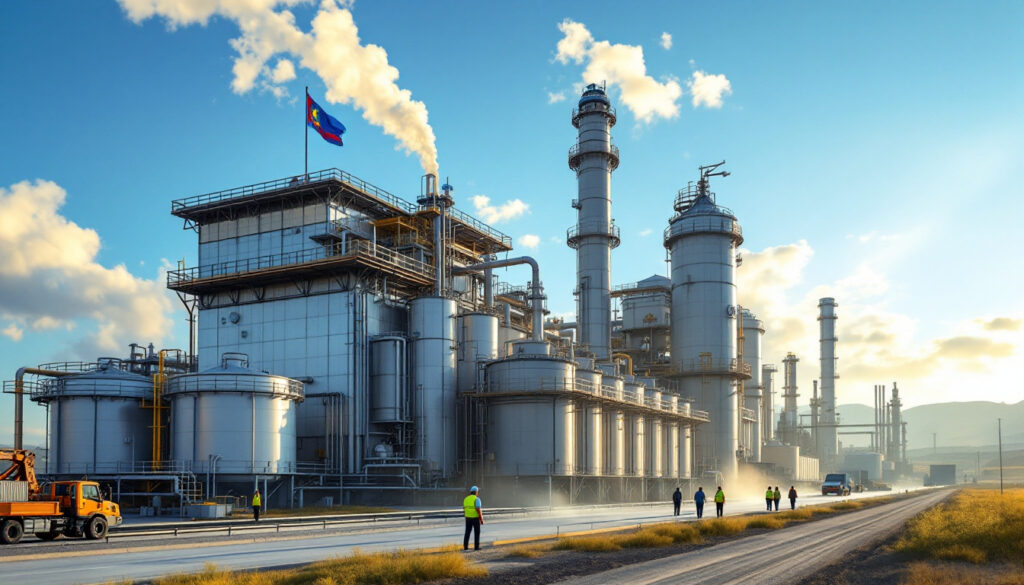Kazatomprom Secures Financing for Strategic Sulphuric Acid Plant Project
The world's largest uranium producer, Kazatomprom, has successfully secured significant financing for its Taikonur sulphuric acid plant in Kazakhstan's Turkestan region. This infrastructure investment strengthens the company's production capabilities and represents a strategic move to enhance its competitive position in the global uranium market. The project comes at a time of increasing uranium market volatility as supply concerns continue to impact prices worldwide.
Project Overview and Significance
The Taikonur sulphuric acid plant project represents a major milestone in Kazatomprom's vertical integration strategy. As a critical component in uranium extraction, securing a dedicated sulphuric acid supply will reduce dependency on external suppliers and stabilize a key production input.
Yerzhan Mukanov, CEO of Kazatomprom, emphasized the project's importance: "This investment ensures operational resilience and reinforces our ability to meet long-term production commitments to global utilities relying on our uranium supplies for clean energy generation."
Financing Structure and Investment Details
The Development Bank of Kazakhstan (DBK) has provided substantial backing for this strategic project:
- Total project investment: 113 billion tenge (approximately $222.5 million)
- DBK loan financing: 85 billion tenge
- Kazatomprom's contribution: Remaining 28 billion tenge from internal funding sources
This financial structure demonstrates strong institutional confidence in the project's economic viability and strategic importance to Kazakhstan's industrial development. Analysts suggest this could create significant investment opportunities 2025 for those interested in exposure to uranium production.
Construction Timeline and Implementation Plan
The company has established a comprehensive development schedule:
- Engineering and design: Completion expected by Q3 2025
- Construction phase: 18-24 months beginning late 2025
- Plant commissioning: Targeted for Q1 2027
- Full operational capacity: Projected by mid-2027
Industry analysts note the timeline aligns with projected increases in uranium demand from new nuclear plant construction globally, particularly in China, India, and the UAE.
Why Sulphuric Acid is Critical for Uranium Production
The Science Behind In-Situ Recovery Mining
Kazatomprom employs in-situ recovery (ISR) for approximately 90% of its uranium production—a method that fundamentally depends on sulphuric acid as a leaching agent. This technique, which is similar to ISR uranium production methods used elsewhere, involves:
- Drilling injection wells into uranium-bearing sandstone deposits
- Pumping acidified solution (primarily sulphuric acid) into the ore body
- Dissolving uranium into solution through chemical reactions
- Extracting the uranium-rich solution through recovery wells
- Processing the solution to separate and concentrate uranium
Dr. Pavel Ryazantsev, mining technology specialist at the Kazakh Nuclear University, explains: "Sulphuric acid creates the optimal chemical environment for mobilizing uranium from sandstone deposits. The efficiency of the entire ISR process hinges on reliable acid supply and quality control."
Consumption Metrics and Supply Chain Considerations
The scale of acid consumption in uranium production is substantial:
| Production Metric | Sulphuric Acid Requirement |
|---|---|
| Per kg of uranium | 75-95 kg of H₂SO₄ |
| Annual requirement for Kazatomprom | ~1.8-2.2 million tonnes |
| Percentage of operational costs | 18-22% |
This high consumption rate makes sulphuric acid supply chain security a critical factor in production planning and cost management. Historical disruptions in acid availability have forced temporary reductions in uranium output at several Kazakh operations.
Current Supply Challenges
Kazatomprom currently sources sulphuric acid from multiple suppliers, including:
- Domestic metallurgical operations with acid as a byproduct
- Chemical plants in neighboring countries
- Distant international suppliers requiring complex logistics
These arrangements have exposed the company to:
- Price volatility: Acid prices fluctuated between $120-290 per tonne in the past three years
- Transportation disruptions: Railway capacity limitations and border crossing delays
- Quality inconsistencies: Varying acid concentrations affecting leaching efficiency
The new Taikonur plant will address these challenges by providing approximately 500,000 tonnes of sulphuric acid annually—covering roughly 25% of Kazatomprom's total requirements. According to a recent MarketWatch report, this plant represents one of the largest industrial infrastructure investments in Kazakhstan's mining sector in recent years.
How This Investment Strengthens Kazatomprom's Market Position
Vertical Integration Benefits in the Uranium Value Chain
By securing an internal sulphuric acid supply, Kazatomprom enhances its operational resilience through:
- Cost stabilization: Reducing exposure to market price fluctuations
- Supply certainty: Guaranteeing availability of a critical production input
- Quality control: Maintaining consistent acid specifications for optimal leaching
This vertical integration follows similar moves by other major mining companies seeking to secure critical inputs. Rio Tinto and Vale have implemented comparable strategies for processing reagents in their operations.
Strategic Timing in a Transforming Nuclear Fuel Market
The investment comes amid significant shifts in global uranium markets:
"Nuclear power is experiencing a renaissance as countries seek low-carbon baseload generation to complement intermittent renewables. Kazatomprom's investment in production resilience positions them to capitalize on this long-term demand growth." — World Nuclear Association Market Analysis, 2024
Key market indicators supporting this strategic investment include:
- Nuclear capacity growth: 60+ reactors under construction globally
- Supply deficits: Production falling short of reactor requirements by ~30 million pounds annually
- Inventory drawdowns: Utilities reducing previously high stockpiles
- Price recovery: Spot uranium prices increasing from $24/lb in 2020 to over $90/lb in 2024
The Taikonur plant will come online as many analysts project a sustained period of uranium market tightness, potentially enhancing Kazatomprom's ability to maintain production while competitors face input constraints.
Competitive Positioning Against Other Major Producers
Kazatomprom's investment reinforces its advantages against key competitors:
- Cameco (Canada): Higher mining costs but strong downstream integration
- Orano (France): Vertically integrated but higher regulatory compliance costs
- CNNC/CGN (China): Growing production but still developing technical expertise
- Uranium One (Russia): Facing increasing international restrictions
By securing sulphuric acid supply, Kazatomprom addresses one of the few areas where its operations faced potential vulnerability compared to fully integrated competitors. This strategic move comes at a time of US uranium market disruption due to geopolitical tensions, potentially giving Kazatomprom additional advantages in global markets.
Environmental and Regional Impacts of the Taikonur Plant
Modern Environmental Safeguards and Technologies
The plant design incorporates advanced environmental protection systems:
- Double-contact double-absorption (DCDA) technology: Achieving 99.7% conversion efficiency
- Tail gas scrubbing systems: Reducing SO₂ emissions to below 150 mg/Nm³
- Wastewater treatment: Zero liquid discharge system for process water recycling
- Heat recovery: Steam generation for power production and process heating
These technologies align with Kazakhstan's increasingly stringent environmental regulations and international best practices for sulphuric acid production.
Carbon Footprint Considerations
While acid production is energy-intensive, the project includes measures to minimize carbon emissions:
- Exothermic process heat recovery: Generating approximately 35 MW of electrical power
- Transportation emissions reduction: Eliminating long-distance acid haulage
- Efficiency improvements: Modern catalyst systems reducing energy consumption
Environmental analysts estimate these measures will result in a net reduction of approximately 45,000 tonnes of CO₂ equivalent annually compared to imported acid.
Economic Development in Turkestan Region
The project delivers substantial benefits to the regional economy:
-
Direct employment creation:
- 400-500 construction jobs during peak building phase
- 150-180 permanent operational positions
- 200+ indirect support service jobs
-
Skills development:
- Technical training programs for chemical plant operations
- Engineering apprenticeships during construction
- Laboratory and quality control specialization
-
Local business opportunities:
- Service contracts for maintenance and supplies
- Transportation and logistics services
- Housing and community infrastructure development
The Turkestan regional government has highlighted the project as a cornerstone of its industrial diversification strategy, moving beyond agriculture and tourism toward higher-value manufacturing.
Operating Challenges and Risk Management
Technical Operational Considerations
Operating a sulphuric acid plant in Kazakhstan's continental climate presents specific challenges:
- Temperature extremes: Design adaptations for -25°C winters and +40°C summers
- Water management: Closed-loop systems to minimize consumption in a water-scarce region
- Seismic design: Engineering for moderate earthquake risk in southern Kazakhstan
Kazatomprom has partnered with experienced international engineering firms to address these challenges, incorporating lessons from similar facilities in comparable environments.
Supply Chain Integration Timeline
The transition to internal acid supply will follow a phased approach:
- Initial production: Supplying nearest uranium operations first (2027)
- Ramp-up period: Gradually increasing output through 2027-2028
- Full integration: Optimizing distribution across all production assets by 2029
During this transition, Kazatomprom will maintain relationships with external suppliers to ensure continuity and manage any commissioning delays.
Safety and Community Engagement
The company has implemented comprehensive safety and community programs:
"Our approach integrates world-class safety standards with proactive community engagement. Regular public consultations and transparent reporting build trust with local stakeholders while ensuring operational excellence." — Askar Batyrbayev, HSE Director, Kazatomprom
Key initiatives include:
- Regular community forums in surrounding settlements
- Emergency response drills with local authorities
- Transparent environmental monitoring with public reporting
- Educational programs on industrial safety for nearby schools
Future Outlook and Strategic Implications
Long-term Production Security
The Taikonur plant represents just one element in Kazatomprom's broader supply chain security strategy:
- Material inputs: Similar initiatives underway for other key reagents
- Energy security: Investments in dedicated power supply arrangements
- Water management: Advanced conservation and recycling technologies
- Transportation capacity: Dedicated rail infrastructure improvements
This comprehensive approach aims to insulate uranium production from external supply disruptions. The company's 2024 annual report, as covered by World Nuclear, highlights how such investments strengthen Kazakhstan's position as the world's leading uranium supplier.
Market Implications for Uranium Consumers
For nuclear utilities purchasing Kazatomprom's uranium, the acid plant investment offers several benefits:
- Enhanced delivery reliability for contracted volumes
- Potentially more stable pricing due to improved cost control
- Greater confidence in Kazatomprom's long-term production sustainability
These factors are particularly significant as utilities increasingly focus on supply chain security and responsible sourcing for nuclear fuel. Investors seeking uranium investment insights may find Kazatomprom's strategic moves indicative of broader industry trends.
Future Expansion Potential
While not currently announced, industry analysts note the Taikonur project design includes provisions for potential future expansion:
- Infrastructure sized for possible capacity increases
- Land allocation sufficient for additional production lines
- Modular design philosophy allowing incremental growth
This forward-looking approach provides flexibility as uranium market conditions evolve in the coming decades.
FAQ: Kazatomprom's Sulphuric Acid Plant Project
When will the Taikonur sulphuric acid plant be operational?
The plant is scheduled for completion in the first quarter of 2027, following the recently secured financing agreement with the Development Bank of Kazakhstan.
How much will the sulphuric acid plant cost to build?
The total project cost is approximately 113 billion tenge (equivalent to $222.5 million), with 85 billion tenge provided through loan financing from the Development Bank of Kazakhstan.
Why is Kazatomprom investing in sulphuric acid production?
Sulphuric acid is an essential component in the in-situ recovery (ISR) uranium mining process that Kazatomprom employs. Having an internal supply improves operational security, potentially reduces costs, and strengthens the company's supply chain resilience.
What is the significance of this project for Kazakhstan's industrial sector?
This project represents a substantial investment in Kazakhstan's industrial infrastructure, supporting the country's position in the global uranium market while creating jobs and economic activity in the Turkestan region.
How will the plant affect Kazatomprom's environmental footprint?
The plant incorporates modern environmental technologies including efficient conversion processes, emissions controls, and waste management systems that meet or exceed international standards. The local production of acid will also reduce transportation emissions associated with importing acid from distant sources.
Will this investment affect uranium prices?
While the investment helps secure Kazatomprom's production capacity, it's unlikely to directly impact uranium prices. However, by enhancing production reliability, it contributes to overall market stability which benefits both producers and consumers in the long term.
Ready to Capitalise on the Next Uranium Market Opportunity?
Don't miss crucial developments like Kazatomprom's strategic investments. Discovery Alert's proprietary Discovery IQ model delivers real-time notifications on significant ASX mineral discoveries, helping you identify actionable uranium and other commodity opportunities before the broader market. Visit our discoveries page to see how major mineral finds can generate substantial returns.




